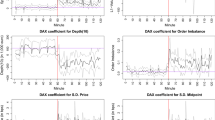Abstract
We build a model under the framework of discrete optimization to explain how high frequency trading (HFT) can be applied to supply liquidity and reduce execution cost. We derive the analytical properties of our model in finding the optimal solution to minimize the overall execution cost of HFT. We show that the execution cost can be reduced after increasing trading frequency (i.e., the higher the trading frequency, the lower the execution cost) with a simulation study. In addition, we conduct an empirical investigation with tick level data from US equity market through January 2008 to October 2010 to verify our conclusion drawn from the simulation study. Based on the simulation and empirical results we collected, we show that the HFT can reduce the execution cost when supplying liquidity.









Similar content being viewed by others
Notes
For example, see Article 51 of The Markets in Financial Instruments Directive (MiFID II) proposed by the European Commission in 2011.
The passive orders are filled quickly when they should be filled slowly and filled slowly when they should be filled quickly, see Jeria and Sofianos (2008).
CFTC (2010). Proposed rules, Federal Register 75 (112), 33198–33202.
See S&P, http://www.standardandpoors.com.
References
Almgren, R., & Chriss, N. (1999). Value under liquidation. Risk, 12, 61–63.
Almgren, R., & Chriss, N. (2000). Optimal execution of portfolios. Journal of Risk, 3(2), 5–39.
Biais, B., Foucault, T., & Moinas, S. (2011). Equilibrium high frequency trading. Working Paper.
Bertsimas, D., & Lo, A. W. (1998). Optimal control of execution costs. Journal of Financial Markets, 1, 1–50.
Chan, L. K. C., & Lakonishok, J. (1995). The behavior of stock prices around institutional trades. The Journal of Finance, 50(4), 1147–1174.
Easley, D., Prado, M., & O’Hara, M. (2012). Flow toxicity and liquidity in a high frequency world. Review of Financial Studies, 25(5), 1457–1493.
Ellis, K., Michaely, R., & O’Hara, M. (2000). The accuracy of trade classification rules: evidence from NASDAQ. Journal of Financial and Quantitative Analysis, 35(4), 529–551.
Hendershott, T., Jones, C., & Menkveld, A. (2011). Does algorithmic trading improve liquidity? Journal of Finance, 66(1), 1–33.
Huberman, G., & Stanzel, W. (2004). Arbitrage-free price update and price-impact functions. Econometrica, 72(4), 1247–1275.
Jeria, D., & Sofianos, G. (2008). Passive orders and natural adverse selection. Street Smart, 33(September 4).
Jovanovic, B., & Menkveld, A. J. (2012). Middlemen in limit-order markets. Working Paper.
Keim, D., & Madhavan, A. (1995). Anatomy of the trading process: empirical evidence on the behavior of institutional traders. Journal of Financial Economics, 37, 371–398.
Lee, C., Mucklow, B., & Ready, M. (1993). Spreads, depths and the impact of earnings information: an intraday Analysis. The Review of Financial Studies, 6(2), 345–374.
Obizhaeva, A., & Wang, J. (2013). Optimal trading strategy and supply/demand dynamics. Journal of Financial Markets, 16(1), 1–32.
Patell, J. M., & Wolfson, M. A. (1984). The intraday speed of adjustment of stock prices to earnings and dividend announcements. Journal of Financial Economics, 13, 223–252.
Sun, E. W., Rezania, O., Rachev, S., & Fabozzi, F. (2011). Analysis of the intraday effects of economic releases on the currency market. Journal of International Money and Finance, 30(4), 692–707.
Sun, E. W., & Kruse, T. (2012). Optimal order submission strategy when market liquidity is uncertain. Working Paper.
Author information
Authors and Affiliations
Corresponding author
Additional information
The authors thank the editor, G. Arivarignan, and two referees for their helpful comments on an earlier version of this paper. The authors thank Cheng-Few Lee and Quentin Chu for their valuable comments.
Appendix
Appendix
1.1 A.1 Proof of Proposition 1
For the induction basis at time t N =T we have

For the induction step for some t n ∈{t m+1,…,t N−1} we get

To obtain the minimum, we differentiate Eq. (14) with respect to \(x_{t_{n}}\)

Setting \(\frac{\partial J}{\partial x_{t_{n}}}\stackrel{!}{=}0\) for Eq. (15) to obtain the optimal choice
where

Putting Eq. (16) into Eq. (14) we obtain the optimal value function given by Eq. (2) and find the coefficients given by Eqs. (4)–(10). This completes the induction for t n ∈{t m+1,…,t N }. We are unsure about market reaction to the event and the following change of the parameters that describe the market. At t m we face the following problem

where q u , κ u , a u and ρ u should indicate that the current value of q and the future value of κ, ρ, and a u are unknown.
Because the event is modeled as a discrete random variable, we obtain

We use \(a_{i}=e^{\mu_{i} \tau}\) and \(v_{i}=e^{(2\mu_{i}+\sigma_{i}^{2})\times\tau }\) and define
Combining Eqs. (17) and (18) with this definitions, we find that

We then obtain the solution that minimizes Eq. (19) is

with

Inserting Eq. (20) into Eq. (19), we find the optimal value function given by Eq. (2) and the coefficients given by Eqs. (4)–(10). For the induction step for some t n ∈{t 0,…,t m−1} we get

To obtain the minimum we differentiate Eq. (21) with respect to \(x_{t_{n}}\)

Setting \(\frac{\partial J}{\partial x_{t_{n}}}\stackrel{!}{=}0\) for Eq. (22) to obtain the optimal choice
where

Putting Eq. (23) into Eq. (21) we obtain the optimal value function given by Eq. (2) and the coefficients given by Eqs. (4)–(10). This concludes the induction.
Rights and permissions
About this article
Cite this article
Sun, E.W., Kruse, T. & Yu, MT. High frequency trading, liquidity, and execution cost. Ann Oper Res 223, 403–432 (2014). https://doi.org/10.1007/s10479-013-1382-8
Published:
Issue Date:
DOI: https://doi.org/10.1007/s10479-013-1382-8




